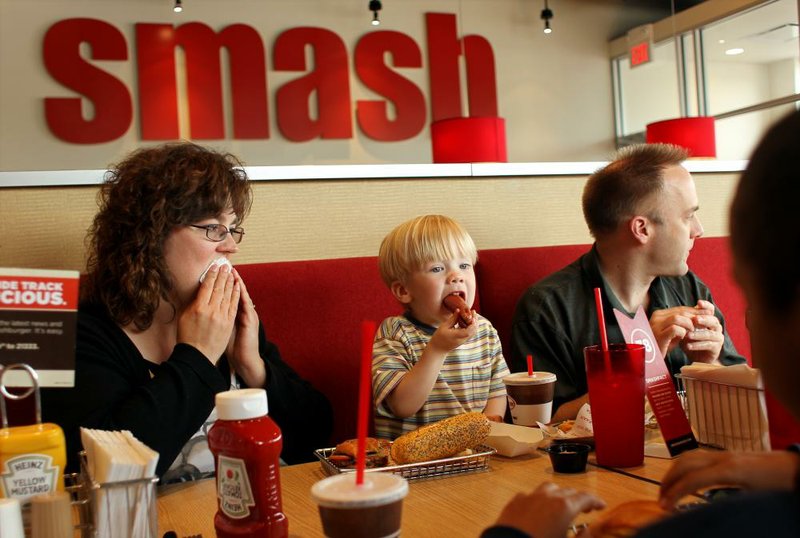CHICAGO — CHICAGO - While the humble burger reigns as an iconic American food, a growing number of foodies are searching for something a little more special: Sandwiches made with fresh Angus beef, a better-quality roll and toppings such as aged cheddar or homemade pickles.
The “better-burger” segment has become one of the restaurant industry’s best performers in recent years, due in part to unprecedented growth by Five Guys Burgers and Fries, known for its handformed burgers, fresh-cut fries and unlimited free toppings.
More recently, a number of up-starts have elbowed in at the table, adding turkey or veggie patties and myriad toppings such as tzatziki (a yogurt-cucumber sauce), dill pickle chips, goat cheese or brie. Some also offer saladsand beer.
The better-burger segment remains a tiny portion of the restaurant industry, with estimated sales of $2.2 billion in 2011, but it grew 21 percent from the previous year, according to a recent report by Technomic, a Chicago-basedresearch firm. That compares with sales growth in 2011 of 3.2 percent for all fast-food and fast-casual restaurants that focus on burgers.
Technomic defines betterburger restaurants as establishments that use fresh meat and make sandwiches to order. That means consumers will have to wait up to 10 minutes or more for a better burger. They also can expect to pay more - as much as $10 for a meal.
But the idea appears to have broad appeal.
On a Friday afternoon, the Smashburger in Elmhurst, Ill., was bustling, with groups of co-workers, families, friends and couples out for celebration lunches, quick bites and family meals.
Heather Hoy and her husband, Blair, were enjoying a lunch with their three children and a nephew in celebration of the last day of school.
She was tackling a Spicy Baja chicken sandwich with pepper jack cheese, guacamole, chipotle mayonsaise and jalapenos. Sweet-potato fries and haystack onions were also hits with her family, she said.
“It’s obviously higher quality than some of the fast-food places,” she said.
McDonald’s continues to dominate the fast-food burger business, posting nine straight years of worldwide same-store sales gains. In recent years, the chain has expanded its menu and kept sales growing.
Salads, smoothies and coffee drinks have helped win back women, but Darren Tristano, executive vice president of Technomic, said serious burger lovers got bored along the way.
“That’s when the opportunity opened, and that’s when the chains jumped in,” he said.
McDonald’s declined to comment for this article. But the chain has chased the better-burger trend, adding Angus burgers with a better-quality bun and upgraded toppings like mushrooms and Swiss cheese.
Tristano said the economy also has been a factor in better-burger growth. “Consumers were looking for familiar products that could be a little better but didn’t break the bank,” he said.
Today, a number of “second-generation” chains can be found, with offerings beyond the ostensibly higher-quality burger and fries.
Newcomers include Smashburger, Freddy’s Frozen Custard and Steakburgers, The Counter and The Habit Burger Grill, all of which grew their restaurant bases by more than 20 percent during 2011. Smashburger sales grew 71.5 percent to $118.7 million as locations expanded to 143 last year.
Smashburger founder Tom Ryan said he began thinking about better burgers a decade ago while conducting research for McDonald’s as the company’s worldwide chief concept officer.
“Although there was an increasing number of burger purveyors, no one was really hitting the ball out of the park around great burgers,” he said. “Even the best iconic ones, the Big Mac, Quarter-Pounder, Whopper, weren’t knocking burger lovers over anymore.”
Denver-based Smashburger also has wooed some McDonald’s franchisees away from the Golden Arches.
Ed Rensi, former chief executive officer of McDonald’s USA, said the idea that Mc-Donald’s has lost its way with burgers is “nonsense.”
“You don’t grow to an $89 billion company by neglecting your core product,” he said. The success of better burger chains, he said, is more a matter of the burger’s ability to sell for a wide range of prices.
“There’s a niche in any industry that you can fill and have a very nice business,” Rensi said, adding that baby boomers, who grew up eating burgers and have disposable income, are some of the best customers.
“They still want hamburgers, but they want them to be different than they had them back in the day.”
These burger chains appear to be building on a winning concept that Lorton, Va.-based Five Guys Burgers and Fries ushered in on a nationwide level when it began franchising in 2002. It’s been the fastestgrowing restaurant chain in the U.S. by sales since 2008, up 32.8 percent in 2011, to $951 million, according to Technomic.
Five Guys has 1,035 locations, founder Jerry Murrell said.
While new burger concepts are “popping up all over the place,” Murrell said, “there’s plenty of room for competition.” But he had words of caution for competitors that are building out the menu beyond burgers and fries.
“When you open a place up you have a tendency to start adding things and get away from the burger [and fries],” he said, adding that he has seen competitors “start having a little trouble with quality.”
“We can’t even make coffee right,” Murrell said.
He’s determined to keep things simple and not try to please everyone. That includes being more concerned with getting the burger right than having it arrive fast.
“We have a sign in some of our restaurants that says, ‘If you’re in a hurry, there are a lot of really good hamburger places close to here,’” Murrell said. “Some of our franchisees are afraid to use it.”
Business, Pages 63 on 06/24/2012

